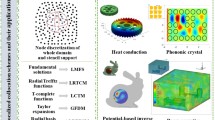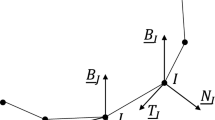Abstract
A technique combining the advantages of conformal mapping and boundary collocation arguments for calculating stress intensity factors for cracks in plane problems is described. The difficulty of finding the mapping function on a rigidly prescribed parameter region is avoided at the expense of using boundary collocation methods on part of the boundary. Conventional collocation arguments are modified by prescribing stress, force, and moment conditions in a least-square collocation sense. These pseudo-redundant conditions provide a reasonable basis for estimation of the effects of inaccuracy of the boundary conditions. The technique is applied to the problem of a circular disk with an internal crack under a loading of external hydrostatic tension.
Résumé
On décrit une technique de calcul des facteurs d'intensité de contraintes pour des fissures en état plan, qui combine les avantages de la méthode de la representation conforme et des méthodes de fixation des conditions aux limites.
La difficulté que l'on rencontre à trouver la fonction de représentation qui correspond à une région à paramètres imposés est levée par l'emploi des méthodes de fixation des conditions aux limites sur une partie d'un contour. Le traitement conventionnel de ces méthodes est modifié en imposant les conditions de contraintes, de forces et de moments en un ajustement par moindres carrés.
Les conditions pseudo-redondantes ainsi réunies procurent une base d'appréciation des effets d'une inexactitude dans la définition du contour.
La technique est appliquée au problème du disque circulaire comportant une fissure interne et soumis a faction d'une tension extérieure uniforme.
Zusammenfassung
Es wird ein Verfahren zur Berechnung von Spannungsintensitä tsfaktoren für Riße in einem ebenen Zustand beschrieben, welches sowohl die Vorteile der Methode der konformen Darstellung als auch die der Verfahren zur Bestimmung der Grenzbedingungen miteinander verbindet.
Die Anwendung der Verfahren der Festlegung von Grenzbedingungen für einen Teil der Außenlinie ermöglicht es die Schwierigkeiten zu umgehen, welche sich dann ergeben wenn man versucht die darstellende Funktion für einen Bereich mit streng auferlegten Parameter zu bestimmen. Die konventionelle Behandlung dieser Verfahren wird dadurch abgeändert, daß die Bedingungen für Spannungen, Kräfte and Momente im Singe der kleinsten Quadratzahlen auferlegt werden.
Diese pseudo-überflüssige Bedingungen ergeben eine Basis zur Beurteilung der Auswirkung einer Ungenauigkeit in der Definition des Umrisses.
Diese Methode wird auf das Problem einer runden Scheibe mit inneren Rissen, welche der Wirkung von äußeren Spannungen unterworfen ist, angewendet.
Similar content being viewed by others
References
N. I. Muskhelishvili, Some Basic Problems of the Mathematical Theory of Elasticity, P. Noordhoff Limited, Groningen, Holland, (1953).
O. L. Bowie, Rectangular Tensile Sheet with Symmetric Edge Cracks, Journal of Applied Mechanics, 31, Trans. ASME, 86, E (1964) 208–212.
O. L. Bowie and D. M. Neal, ‘Single Edge Crack in Rectangular Tensile Sheet’, Journal of Applied Mechanics, 32, Trans. ASME, E, 708–709, (1965).
B. Gross, J. E. Srawley, and W. F. Brown, Jr., Stress Intensity Factors for a Single-Edge-Notch Tension Specimen by Boundary Collocation of a Stress Function, NASA TN D-2395, Lewis Research Center, (1964).
A. S. Kobayashi, Method of Collocation Applied to Edge-Notched Finite Strip Subjected to Uniaxial Tension and Pure Bending, Boefng Company, Seattle, Washington, Document No. D2–23551, (1964).
F. Nehari, Conformal Mapping, McGraw-Hill Book Company, Inc., New York, (1952).
O. L. Bowie, Analysis of Edge Notches in a Semi-infinite Region, Journal of Math. and Phys., 45, 4 (1966) 356–366.
P. C. Paris and G. C. Sih, ‘Stress Analysis of Cracks,’ Fracture Toughness Testing and Its Applications, ASTM STP 381, Am. Soc. Testing Mats., 32, (1965).
W. F. Brown, Jr., and J. E. Srawley, Plane Strain Crack Toughness Testing of High Strength Metallic Materials, ASTM STP 410, Philadelphia, Pa., (1966).
M. P. Sheremetjiev, The Elastic Equilibrium of an Elliptic Ring, Prikl. Mat. i Mech. XVII, No. 1 (1953) 107–113.
Author information
Authors and Affiliations
Rights and permissions
About this article
Cite this article
Bowie, O.L., Neal, D.M. A modified mapping-collocation technique for accurate calculation of stress intensity factors. Int J Fract 6, 199–206 (1970). https://doi.org/10.1007/BF00189828
Received:
Issue Date:
DOI: https://doi.org/10.1007/BF00189828




